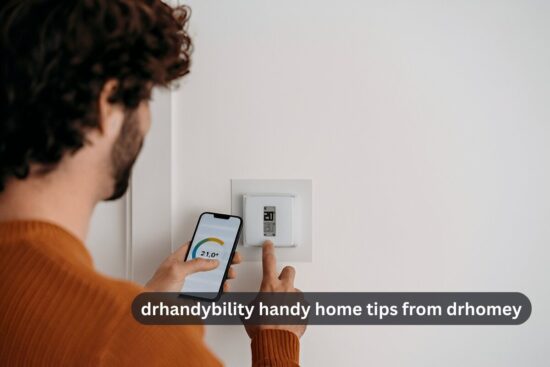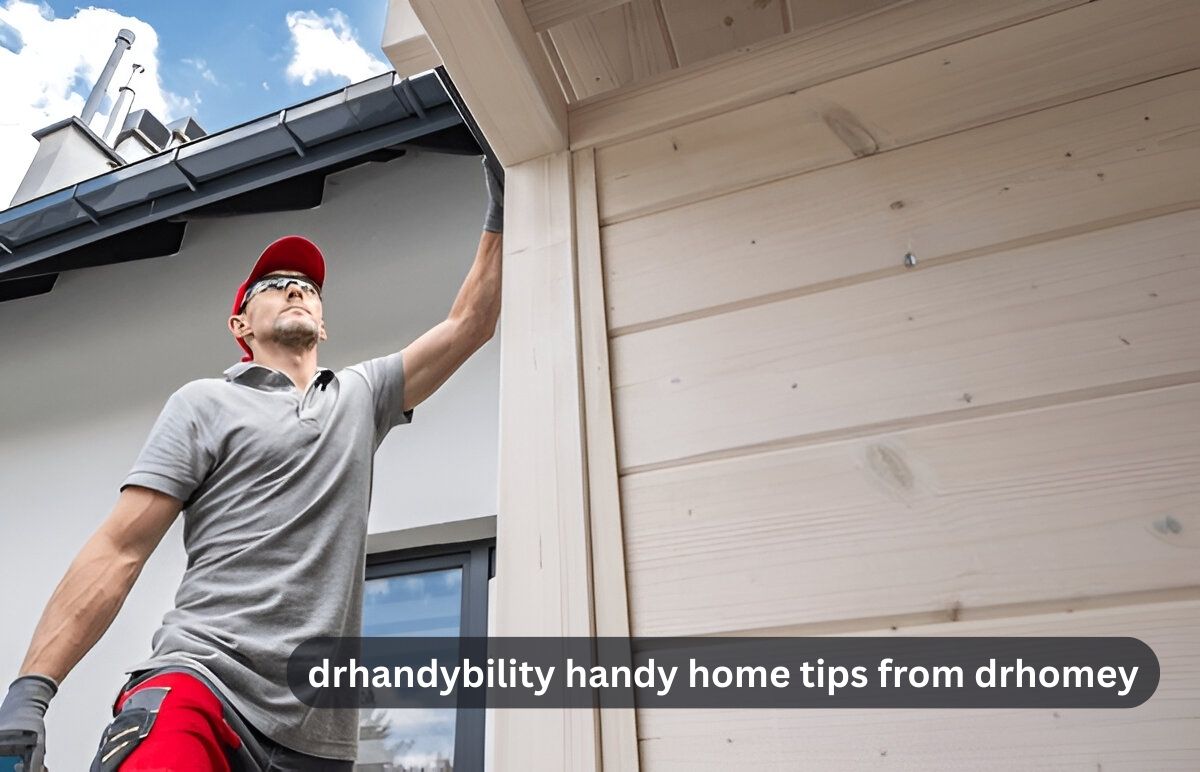Here is a clear promise. You want practical fixes that work in real homes across the United States. Drhandybility handy home tips from drhomey gives you that. You get small steps that add up to safer rooms, lower bills, and less stress. No hype. No jargon. Just what to do and why it helps. This guide explains how to use drhandybility handy home tips from drhomey in daily life. It covers safety basics, energy wins, healthy air, simple maintenance, smart organizing, budget upgrades, and family needs. You will see examples that match everyday situations. You will learn where a few dollars saves hundreds. You will find routines that take minutes, not hours. Most of all, you will feel in control of your home. Use drhandybility handy home tips from Dr. Homey, along with tips drhomey and drhomey handy tips, to make steady progress without waste or worry.
Safety first at home
Start with protection. Working smoke alarms and carbon monoxide detectors save lives. Test the alarms every month. If your model requires batteries, replace them at least once a year. When the unit has reached the brink of its useful lifespan, it should be replaced. Place alarms on every level and inside bedrooms. Add carbon monoxide detectors near sleeping areas and outside the furnace room.
Child safety needs steady habits. Secure tall furniture to studs. Add latches on lower kitchen cabinets that hold cleaners. Keep blind cords out of reach and away from cribs. These steps prevent many common injuries in family homes.
Use a short monthly check. Walk the home and check trip hazards at stairs and entries. Confirm fire extinguishers are ready. Label water and gas shutoffs so family members can act during a leak or smell of gas. Keep flashlights with fresh batteries in the kitchen and the main bedroom. Small steps like these fit the spirit of drhandybility handy home tips from drhomey and give real peace of mind.
Cut energy waste without stress

Energy bills feel heavy when heating or cooling swings. A smart thermostat brings steady savings with little effort. Average homes save around fifty to one hundred dollars a year depending on schedules and use. Set times that match sleep and work hours. Keep vents open for even airflow.
Hot water is another quiet cost. Lower the water heater temperature to one hundred twenty degrees. This cuts energy use and scald risk. Hot water pipelines should, if possible, have the first several feet insulated. Fix dripping faucets within a week. A slow hot water leak wastes energy and money.
Stop drafts around doors and windows with weather stripping and caulk. Focus on the door to the garage and any attic hatches. These spots leak more than you think. Drhandybility handy home tips from drhomey, along with drhomey handy tips, emphasize simple tools and repeatable tasks.
Clean air that helps you feel better
Cleaner indoor air starts with the right filter and a steady change cycle. Many homes can run a higher efficiency filter without strain. MERV 13 filters capture far more fine particles than basic models.
Add habits that keep air clean. Do not burn candles or incense daily. Vent cooking with the range hood set to exhaust to the outside. Vacuum with a HEPA upright at least once a week in bedrooms and living areas. Open windows for short bursts when outdoor air is healthy. Place a portable HEPA purifier in the bedroom of a person with allergies or asthma.
A small but strong tip is to put a reminder to check filters on the first Saturday of each month. It fits the routine style of drhandybility handy home tips from drhomey and keeps air quality steady.
Weekly and seasonal maintenance
Set a weekly reset that takes twenty minutes. Put tools back on their hooks. Clear the mail pile. Run a quick bath and kitchen sink check for slow drains. Wipe fridge door seals and check for cracks.
Each month walk the home with simple targets. Test smoke and CO alarms. Inspect outlets by pressing test and reset. Look at the dishwasher and sink base for moisture. Clean the dryer lint screen and check the vent outside for good airflow. Look for caulk gaps around tubs and showers. Touch up before water gets behind tile or trim.
Plan for weather. Before summer, clear leaves from the AC condenser and trim plants away on all sides. Before winter, replace worn weather stripping and place a draft stopper at the attic hatch if needed. These habits come straight from drhomey advice on designing smarter homes that work with the seasons.
Water protection and plumbing care
A tiny leak can waste hundreds of gallons and cause mold. Catching it early saves walls, floors, and cabinets. Check under sinks and around toilets once a month. Look for a white crust near joints, which often means a slow leak.
For clogs, start gentle. Use a drain snake or a plastic hair tool. Avoid pouring strong chemicals that can hurt pipes and traps. Use mesh strainers in showers and kitchen sinks. Pour hot water to clear grease films after big cooking days.
Know your shutoffs. Label the main water shutoff and the local valves for sinks and toilets. A burst line becomes a small event when you can shut off water fast. Keep two braided stainless supply hoses on hand for quick swaps.
HVAC care you can do
Replace or clean filters on the schedule your system needs. Many homes do well with a one to three-month cycle. Keep return grilles clear of furniture to reduce strain.
Look at the condenser outside. Clear leaves and dirt. Maintain two feet of open space around it. Inside, keep floor vents open in lived in rooms to stabilize airflow.
Know when to call a pro. If you hear grinding or smell an electrical odor, shut the system off and book service. Record filter changes and any noises with dates. This log helps the tech solve problems faster and saves you money.
Organizing for busy families
The entry is the control point. Place a small tray for keys and a bin for mail right by the door. Hooks at eye level handle daily bags and light jackets. Shoes go on a mat with ridges so dirt stays put.
In the kitchen use a simple flow. Prep area by the sink. Cooking tools near the stove. Keep heat-safe utensils in one easy-to-reach container. Store snacks low if you want kids to serve themselves.
Laundry piles shrink when you run smaller loads more often. Keep a basket in each bedroom. Wash when a basket is full. Fold near the dryer and put clothes away right away. This habit is the heart of drhandybility handy home tips from drhomey because it is short, honest, and sustainable.
Budget upgrades with real impact
Swap in LED bulbs where lights stay on the longest. Hallways, kitchens, and living rooms bring quick payback. Add a smart thermostat if you have not already. Weatherstripthe front door and the door to the garage. Caulk gaps at trim where you feel drafts.
Add foam gaskets behind outlet covers on exterior walls. Close the attic hatch with better weather stripping and a rigid cover. These spots leak more than windows.
Pick one room for a small comfort upgrade. A thicker rug pad in the living room softens steps and adds insulation. A blackout liner in the bedroom improves sleep and comfort in both summer and winter.
Kid-friendly rooms without clutter
Start with storage that kids can use without help. Low open bins for toys. Soft baskets for stuffed animals. Anchor bookshelves and dressers to studs to stop tip-overs. Use cordless blinds or wrap cords high and out of reach.
Create a play zone that can reset fast. Keep messy crafts at a table with a mat under it. Store markers and glue in a handled caddy.
Make sleep spaces calm. Keep only a few soft items on the bed. Block bright street light with blackout liners. Use a white noise machine on a low setting if outside noise is a problem.
One more insight. Rotate toys. Store half in a closet and swap every two weeks. Kids feel like toys are new, and the room stays clear. It is a simple drhandybility handy home tips from drhomey habit that keeps order without nagging.
Build your drhandybility habit
Habits beat sprints. A ten-minute daily plan is enough. Do dishes. Wipe the counters. Put shoes and coats away. Take out trash if it is close to full.
Use a one-hour weekend plan. Pick one maintenance task, one organizing task, and one comfort task. Record what you did in a simple note on your phone. Over a season these small wins stack up.
Track savings. Use energy and water bills to measure progress. When you see real savings, your motivation grows. Tie that feeling to the next small step, and you have a loop that keeps going.
Your home should support your life, not demand all of your time. The drhandybility handy home tips from drhomey approach keep actions small, steady, and proven. That is how you create a safe, efficient, and healthy space without burnout.
